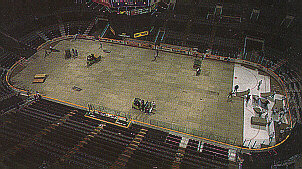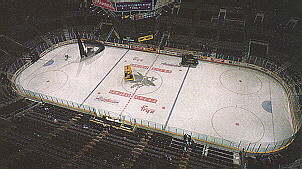|
|
|
|
Just How Do You Create a Rink? |
|
| Beneath every arena floor is a massive refrigeration system, which pumps brine (i.e. cold 're-mineralized' salt water) through miles upon miles of pipes, each attached to large pieces of concrete known as the "ice slabs." | |
 |
|
| When the slabs are cold enough, layers of water are applied. The first few layers are painted with the standard blue and red hockey markings, such as the zone lines, face-off circles and creases. Eight to ten more layers of ice are stacked as each freezes, until the completed plates are approximately one inch thick. | |
|
Over 10,000 gallons of water are used in the rink freezing process. |
|
|
|
|
| Once created, the ongoing task of maintaining ice quality requires the use of the Zamboni, a mechanical resurfacer which scrapes the snow off the ice to be discarded and flushing any grooves with water to loosen debris. Finally, the Zamboni puts down a thin layer of heated water, which then freezes and creates a smooth ice surface. | |
|
A pro Zamboni can heat water up to 140 degrees Fahrenheit! |
|
|
|
|
| "Fast ice" is harder and colder with a smoother surface, while " slow ice" is warm or soft, with a rough surface. For players, "fast ice" is less chippy, with less powder, making puck passes much easier. The quality of the ice differs during the course of the game and it can even change how teams play. At the end of periods when the ice tends to get 'snowier,' and the puck tends to bounce, so players tend to make safe plays rather than finesse plays when "slow ice" or "bad ice" conditions exist. | |
|
Visit the Ice Rink section at HowStuffWorks.Com for more! |
|



